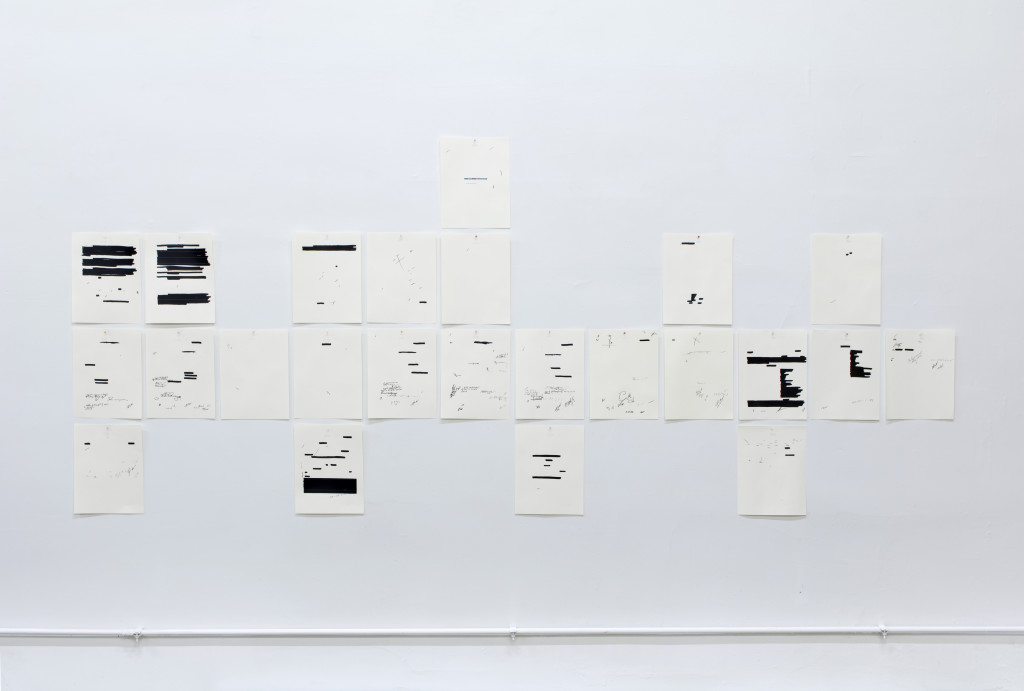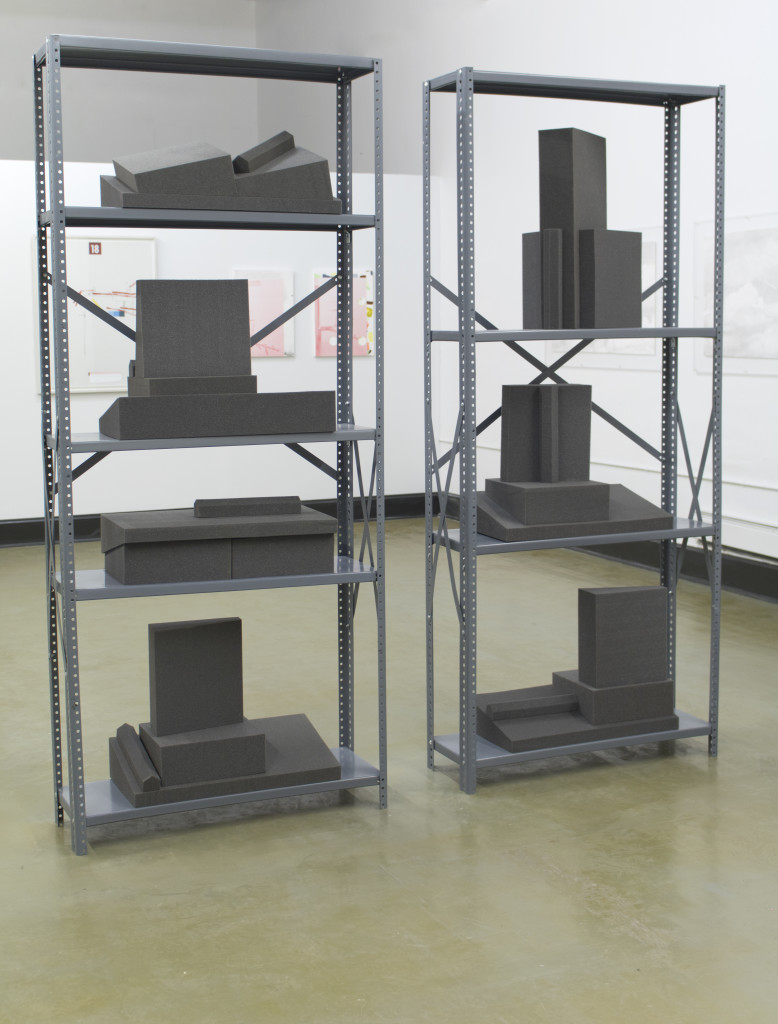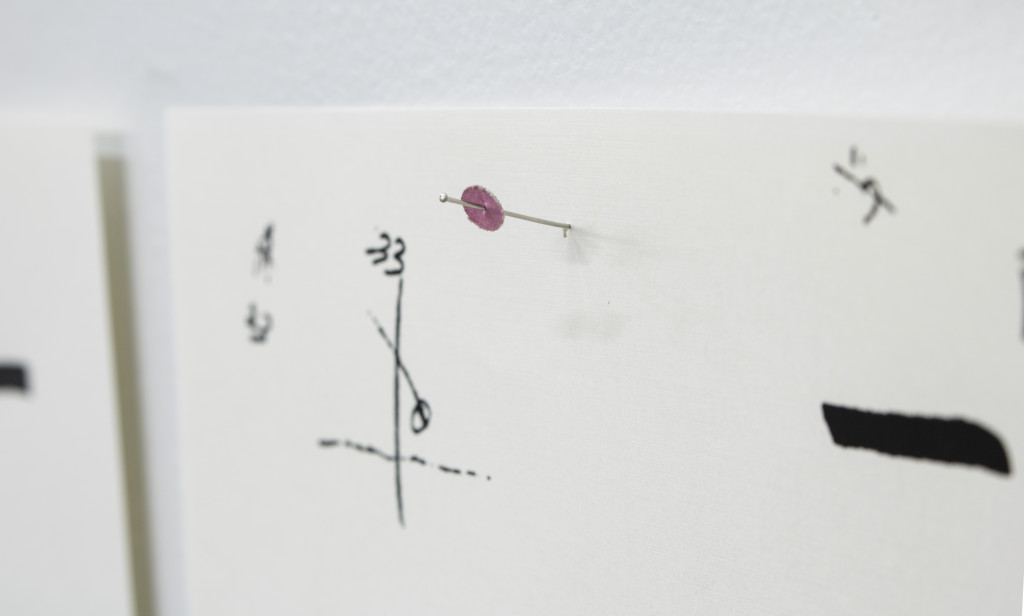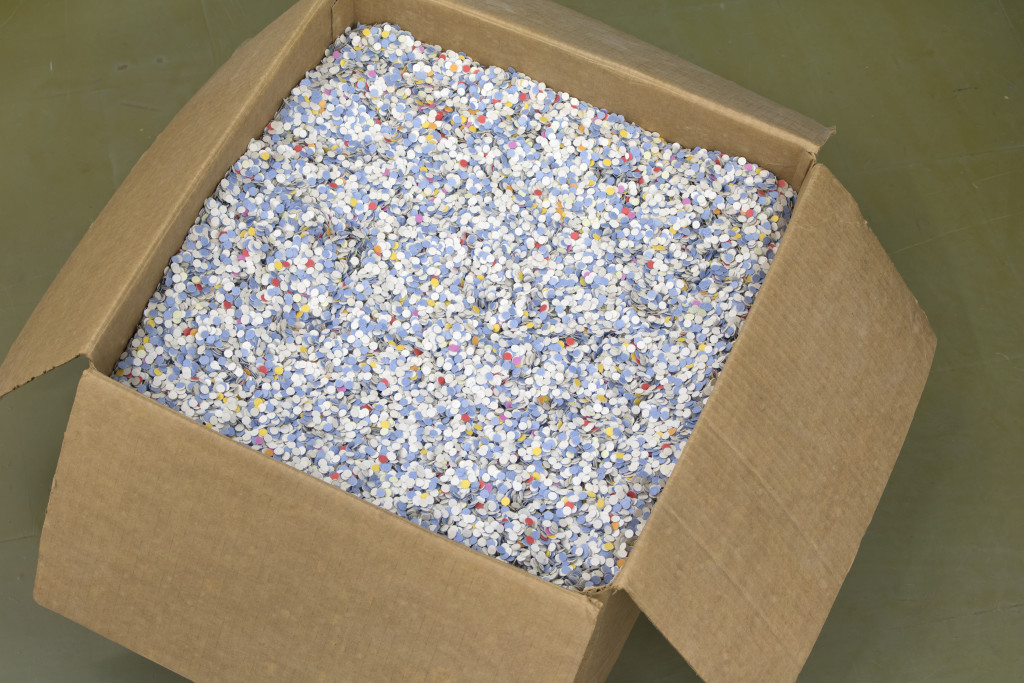Jeff Prokash: Triumph Gallery
by Ruslana Lichtzier
Jeff Prokash’s ongoing research project, Objects for a Production in Eleven Acts, examines the resonant nature of objects and spaces as they operate within a singular information system. With each new exhibition, the set objects—which range from FBI files obtained through the Freedom of Information Act, requests on German fiction writers, to boxes of unused confetti collected from a shuddered nightclub in rural Wisconsin—is re-edited and restaged. Placed in arrangements that echo sites such as public storage facilities and restricted government archives, the specific arrangements provide an inside view to the sites and systems that give projects their form.
Ruslana Lichtzier: How did your interest in systems evolve, when did it start?
Jeff Prokash: I used to be a painter, not that you would be able to tell from the work I’m making now, but there was a point where I was painting and slowly I sort of became enamored with the objects that I would paint. I was making paintings where there would be an object centrally located in the middle of the canvas and the rest would be a colored field that was activating the object. It occurred to me then that maybe I should switch to working sculpturally instead while continuing the dialogue that is attached to different objects. I think it started then and has gone in various different directions since.
Ryan Coffey: Is that something that evolved in graduate school?
JP: This was actually in the space between graduate school and undergraduate. That I noticed the shift in my practice. From then on it became more of an investigation of how objects operate in the world while delving into the fictions and the sets of agreements that are attached to the spaces, the objects and the materials I am investigating. I began to challenge those relationships, opening them up and activating different conversations that are attached to them.
RL: If I hear you correctly, the interest in systems started from you understanding a kind of a misrecognition regarding your medium, you understood that you operate within a wrong system and then transitioned to the correct one?
JP: Yeah, I think that in painting I was doing too much of the telling and less letting the objects and the materials bring what they could bring to the table.

RC: Do you miss the sensuality of painting?
JP: I would say that it moved, that my practice is still very sensual. It looks dry and people can at times criticize the dryness, but I feel that sensuality in my fingertips. I would say that it is still in the center and maybe the reason for the way I work. Everybody else is clearly not having the same sentiment towards it, but for me, it usually starts from a material attraction that I then dig into.
RL: The Concrete Slumps are very sensuous and sexualized, curvy and stiff at the same time…
JP: They are floppy things, like a bunch of slugs that are, like, mating or something I guess.
RC: What would happen if, let’s say hypothetically, you took the specifics completely out, would you still be making the same things?
JP: I try to expand this spectrum, and actually the Concrete Slumps are not specific in any way. The only way that they are specific is that there are two materials, there is cement and there is foam, and both come with different properties, and I have combined them to make a new property that was unforeseen.
RC: Are they cast forms?
JP: No, they are just upholstery foam that’s saturated with wet cement.
RC: Oh, I did not know that!
JP: Once the cement hardens it locks them in place. The foam absorbs the cement while holding its shape. In that period before it hardens, it is affected by gravity and becomes this lazy, slumpy thing. It locks it in that moment; as if it was sinking into itself. So, they are specific in terms of materials, but not in other terms, such as historical context and so on. A trip I had to Berlin was maybe the point I started to be interested in working this way. Being in a city that is unfamiliar to me and is so activated by history, a city where you can feel its history built into its environment, which I guess you can feel that anywhere… but with me being a tourist it heightened that sense. There was something there, where moments in time were congealed into the built environment, that made those foam concrete slabs make sense to me.
RL: Are you German by descent?
JP: I am German by descent; German and Belgian and Czech, so that’s a variety of things.
RL: When you visited Berlin, did you feel like you were coming back to like almost a lost origin?
JP: No, no, I don’t think so. I don’t think it has to do with my personal history, though a lot of the work in this project gravitates to that specific segment of history.
RC: It sounds like you are describing more like inspiration from taking a walk, except you happened to be in Berlin.

JP: Yeah. There was something about that place, the way that history is being commodified and represented there to the visitors that I got fascinated about.
RC: Yeah, I love the Gedächtniskirche bombed Church. It is both brilliant and hilarious. It is a wonderful reminder, and at the same time, it is a totally commodified capitalist behavior that showcases tragedy as museum education in the public sphere.
JP: Yeah. There’s a weird mix there of facts and fiction, and how they get integrated into the built environment.
RL: What do you mean by “fiction”?
JP: For example, last time I was there I visited the Berlin-Hohenschönhausen Memorial, which was a Stasi Prison. They are representing history there, recounting it by using first person stories. Then there’s a second layer of these directional walkways with placards. It positions you to look at that environment and at that history in a very specific way. Somebody made decisions how to control your view and provide the specific angle.
RL: Right. They provide a specific perspective, but it is not fiction.
JP: No, it is not, but I think that there is something about it, that the perspective is malleable and can change; it can be presented in a different way in different conversations, and it might even be the opposite.
RC: It is a controlled narrative.
RL: A controlled narrative is still not a fiction. History is a combination of selective facts that are structured in a selective manner but it is not fiction. There is a huge difference between fiction and history.
RC: I don’t agree with you, because any museum is a fiction.
RL: Well, that is absurd not to agree that history is not fiction, because there is a meaning in history.
JP: I would suggest that things develop and become mythologies. They get packaged in a way that all sorts of other stuff get written into it.
RL: I don’t think its mythology either, it is an ideological construct of history.
JP: I think the way culture becomes and gets pushed forward and moves along is in a sort of stratified way. Fictions are inserted in between the layers. I’m interested in parsing out those things: the assumptions that are made towards these objects, and the assumptions that are made towards their context, where is their potential to develop to a fiction, and where they are concrete. Where is that space where malleability begins and ends, and how far can they play with that?
RL: Yeah, I think that these are wonderful questions. Though, we should add more words, besides “fact” and “fiction.” There is ideology, that is fictional because it is perspectival, but it is different from the way that a fictional narrative operates.
JP: Yeah, that’s too binary, this conversation between fact and fiction, while I am actually much more interested in that big gray area that exists between the two.
RC: In reading your press release text, and now hearing you talk, I am picking up a gap. The text is didactic and explanatory, while the way you are talking about the work now is much curvier and all over, not centrally located. I wonder if that’s an intentional move, in terms of leading people to look at the work a certain way?

JP: Yeah, entirely. This project that I’m working on, I consider it to be a fiction. It is a fiction in the making, but it uses facts, history, real things. I feel like I’m writing a novel. I’m doing the research that leads up to the novel and then later I will write that novel. Actually, I will never write the novel but, hypothetically speaking, I had to first become an expert in all of these things in order to then make a believable fiction. I had to establish a set of agreements. So I have to frame it to some degree, and now I’m training my viewer each time I’m showing the work, and it trains me also, because I feel like the work is the negotiation between me, the viewer and the materials, and they open up over time and become… something new emerges from it.
RL: I wonder … maybe it is an unfair question, if it is, tell me… but, I’m very curious about the position of the artist as a culture producer and the artist as a person, as a human being. I feel like you completely separate the two. If that’s true, why and how have you decided on the separation?
JP: I don’t know if I have. I guess I have in this project. I think of “Objects for a Production in Eleven Acts” as a set of parentheses that I’m working within. In it, I get to be fictionally myself, as an artist and a researcher, even though in real life also I am curious about research and enamored with materials. But in the work I put myself as the conductor, the orchestrator, the custodian. This allows me to look at myself from the outside, and be critical of myself and how I am interacting and participating with the art world. As far as authorship on this piece goes, I have to, to some degree, sign off on ownership because the project has a trajectory that changes over time. These conversations, for example, things will come up in them and then they’ll find their way into the work, because the project allows it. The relationship between the persona of the artist and the cultural producer are different here because the timeframe of this work is so much longer and the dialogue is much more open. We are going to have this show here next week and these pieces are going to be presented. I will have conversations with people and things will come up, and that will change how I produce the next exhibition of the same pieces.
RC: I was meaning to ask this question; which Jeff are we talking to? I mean, is this a performative space where Jeff the researcher is explaining this project? Personally, I was used to being so clammed up when I spoke publicly that I ended up creating another person, who was telling me “you are going to sit over there,” and this other person came inside for the required period of time, until those two people finally merged.
JP: That happens to me with this work. This work started to become sort of self-fulfilling, self-created reality. Over time it shapes me as a person that I become, even though in the beginning I was doing it as an experiment.
RC: That’s really interesting to me, you said you being a conductor, it is like there’s one self-conducting, and the other self is absorbing. It is a really fascinating perspective.
JP: Sure. This is where you slowly realize you have some sort of personality disorder or something.
RC: We all have one. It is such a leap of faith to think that you could do anything.
JP: Yeah. The thing is, now the work starts to make itself. It got to a point where it is going, it is bigger than me. I am maybe steering it a little, a lot, but it starts to shape me as much as I was initially shaping it.
RC: Every system needs a container, right? What is your container then?
JP: I would say that the framework of the project is the contai r, and that the container is shaped by the content. So, what is the content of the work? The content of the work could be the German histories, architectural histories, all of these other things. I would also say that the content of the work is the work itself, that is actually the content of the work…
RL: It takes an apparatus to shift the contents of the work which is the form.
JP: Yeah. It is really about form, it is about how something takes shape, and how it then develops its own system and its own history. The work is making its own history and eventually we’ll be able to look back at it and go, “Oh, this is what happened,” and then we can look at it from the outside, but the making is experimental, we get to play with it, as it moves forward.
RC: I’m really interested in this, so I brought this up before, but, the writing, I was like, “Okay, he wants me to think about this. These are the parameters.” Whereas talking about it, this may sound like a critique, I’m getting much richer information in the way you that you are including yourself in the process. In the text, it seems like somebody else wrote it, where it sounds like you are so intimately inside, intrinsically inside.

JP: But see, that’s where East Germany comes in. I live in a reality that I’ve grown up in, so East Germany is an alternative, just another alternative. It allows me to step over and think of other possibilities that can happen under a different set of realities. I wanted to take something that would allow me to see myself from the outside in, so part of why I explored these other histories. It is not about… the project is not about East Germany. It is about opening up a binary and stepping into it is in between.
RL: I think what Ryan is aiming towards is further steps of exploration. How you present the text for the work in a performative way? Because the press release still operates as a standard text and it may be interesting for you to open up these relationships.
JP: Yeah, for sure. I think you are right that there is a lot of room for me to take on a mode of writing that opens up the work in a new way. So far, even though I’ve been working on it for two years now, the project still seems fresh to me and I still feel like I haven’t opened it up publically yet, so I still feel like I need to provide a packaged answer. I think that it will come, it is just that right now I still feel like I have too many skeptical viewers. I don’t want it to derail too much into these fictions before I first establish the facts.
RC: I like that idea a lot. It is almost like it doesn’t matter if anyone is seeing what I’m seeing yet, as long as this is here first. Then later I’m going to go back and see where the foundation is.
RL: I also like the long-term relationship for the viewer that is counting on long intervals of time, which is a unique approach.
JP: Yeah, for sure. Ideally what I would like to happen is somebody comes in and sees the work for the first time. They are seeing a very small facet of the work and it confuses them, they don’t understand what they are looking at. Then, maybe six months later, they encounter the work again. In the meantime, they’ve had a conversation or two, and now with the re-encounter, the repeated viewing unlocks the piece a little more. The work expands slowly over time and produces a culture around it. Sometimes, I present so many objects … I could explain all day how all they are interrelated, but I know that the viewers may come and be like, “What the hell am I looking at? These are shelves and shelves of junk essentially.” And then there’s this list, this long list that’s equally impossible to read and decipher, and all it tells you is that there is stuff in there that you are looking at something from the outside that you can’t decipher. That is an exercise in alienation that I’m trying to produce. I don’t expect people to get into this space and really understand. Though I know some people are curious and some people will do it, and they will pick it apart.
RC: There’s a generosity that I see in your work, although it has similarities with work that I’ve seen before, it doesn’t have the same feeling. Here, there is a familiar coldness, but then also warmth, that doesn’t have that safe feeling.
JP: I mean I would say I’m an introverted person which comes as no surprise to anybody. I think I am making an introverted work in that same way, that to some degree it requires patience and time to pick away and look at it from the outside for a long time before you even get to the inside. Once you get inward, then there’s a whole different experience that sort of was not realized before. I think I sort of count on that a little bit.
DOOR, the group exhibition of Dan Devening, Greg Bae, Jeff Prokash and Anna Shteynshleyger ran at Triumph Gallery until March 26.